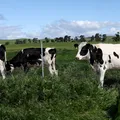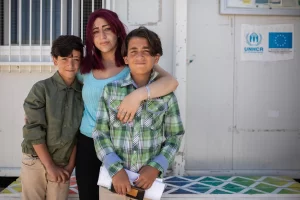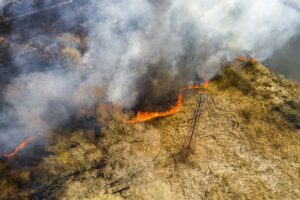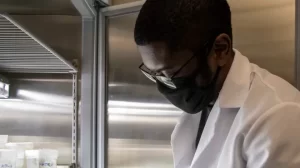Michigan has become ground zero for the highly pathogenic H5N1 avian influenza virus that’s sweeping the nation, killing turkeys, chickens and wild birds, infecting cows and other mammals – and now has sickened a third U.S. farmworker.
The Great Lakes state has more dairy cattle herds known to be infected with avian influenza than any other state in the U.S., with 24 outbreaks in 10 counties as of Friday, according to the U.S. Department of Agriculture. It now also has two farmworkers with confirmed bird flu infections – transmitted to them by close contact with sick cows.
Texas is the only other state where a person is known to have contracted the H5N1 virus from a cow, according to the U.S. Centers for Disease Control and Prevention. That state has reported 15 cattle herd infections since March. Seven other states – Idaho, South Dakota, Colorado, New Mexico, Kansas, Ohio and North Carolina – also have cow herds with known infections, the USDA reported.
The reason Michigan’s tally of livestock outbreaks and farmworkers with avian influenza is higher than other states is not because Michigan is especially ripe for viral activity or because there’s something different about the state’s cows or workers, said Dr. Arnold Monto, emeritus professor of epidemiology and global public health at the University of Michigan and co-director of the Michigan Center for Respiratory Virus Research and Response.
“The main reason we’re detecting more infection is because we’re doing very good surveillance,” Monto said. “Other states need to do the same. … It’s being missed.”
The CDC reported May 22 that 40 people had been tested for highly pathogenic avian influenza nationally. The same day, Dr. Natasha Bagdasarian, Michigan’s chief medical officer, told the Free Press that 35 Michigan farmworkers had undergone testing.
That means only five people tested as of May 22 were from states other than Michigan. It also means the reach of the virus “is certainly more widespread” nationally than anyone currently knows, Monto said.
“The conclusions are pretty obvious when you hear things like that,” said Monto. “If you don’t look, you’re not going to find it. What we need is to get serious about it in terms of how we handle surveillance because if you don’t know it’s there and don’t have regulations in place … it’s going to spread even more.”
The CDC updated its testing and monitoring data Friday, saying 44 people have now been tested nationally for the highly pathogenic H5N1 virus, and more than 390 people have been monitored as a result of their exposure to infected or potentially infected animals.
The agency said it is also stepping up national surveillance/testing by:
- Asking local labs to send more samples for subtyping to the CDC and state public health labs to test for the H5N1 virus.
- Extending reporting of flu-related hospitalizations through the Influenza Hospitalization Surveillance Network. The CDC typically stops reporting influenza hospitalizations from May-September because it’s ordinarily such a seasonal virus. So far, the CDC said its surveillance systems show no indication of unusual flu activity in people.
- Increasing outreach through state and local health departments to health care providers and clinics about H5N1 symptoms so avian influenza is considered when patients with conjunctivitis or respiratory illness and a history of exposure to animals seek medical care.
How the virus came to Michigan cow herds
The outbreak of H5N1 virus in dairy cattle – with spillover to humans – began in Texas just a few months ago. It came to Michigan in late March, when infected cows crossed state lines, said Tim Boring, the director of the Michigan Department of Agriculture and Rural Development.
“We know that a farm in Montcalm County initially (had an outbreak) as a result of cattle movement,” Boring said, “and we’ve seen an expansion of our cases out of that general area since then.”
Calling the H5N1 outbreak among poultry and cattle in Michigan an “extraordinary emergency,” Boring issued an order May 1 that required all dairy and commercial poultry farms in Michigan to adopt biosecurity practices to slow the spread of the virus.
Among the requirements: Farms must secure animal areas, establish a perimeter and limit access. They must name a biosecurity manager and train employees, and establish cleaning and disinfection practices for all with contact within the perimeter, including delivery drivers. They must keep log books tracking all who enter and leave.
More:Avian flu has spread to cows, milk — and experts worry human outbreak could be next
The order also prohibited all lactating dairy cattle, and those in the last two months of pregnancy, from being exhibited at fairs and festivals until there are no new cases of the virus statewide in dairy cattle for at least 60 consecutive days. Similarly, poultry also cannot be taken to exhibitions, fairs or festivals until no new cases of the virus have been detected in domestic poultry for at least 30 consecutive days.
The state agriculture department also teamed up closely with state and local health departments to ensure people would be protected, Boring said.
“In Michigan, we’re testing in animals and we’re testing in people and we’ve seen really strong coordination between animal and human health components within the state level, the federal level and on the local level,” he told the Free Press on Friday. “Part of the reason that we’ve seen good responses on testing is because of the involvement of local health departments. Those are trusted community partners. They are neighbors, not folks coming in from out of town. We’re taking this really seriously. It’s a proactive approach. This is both an animal and a public health concern, and we’re managing it as such.”

Still, Boring said, there are many unanswered questions about this virus, including how it spreads.
“We likely have a multifactorial transmission matrix going on of how the virus spreads from dairy farm to dairy farm. … We’re getting a better handle on it every day, and we’re continuing to lead across the country of what the response looks like.”
Human cases so far have been mild
All three people known to be infected with highly pathogenic avian influenza in the U.S. this year have had mild symptoms.
The Texas farmworker and the first person in Michigan to get ill from exposure to infected cattle reported only conjunctivitis, or pink eye. In the second Michigan case, which was announced Thursday, a farmworker had upper respiratory tract symptoms, including cough without fever, and eye discomfort with watery discharge, the CDC reported.
There is concern among scientists that the impact on people could change, as more animals get infected.
The more the virus spreads in animals, the greater the likelihood of human exposures and transmission, Monto said, which also increases the odds that the virus could mutate in a way that would allow H5N1 to spread from person to person or cause more severe disease.
“That’s why we really need to control it – not because we’re sure that is going to happen, but because if that does happen, there’s a chance it’s going to be pretty bad,” Monto said.
The CDC is conducting genetic sequencing on the most recent human case in Michigan to determine what, if any changes, there might be.
All three known human cases so far involved the 2.3.4.4b lineage of the virus that is nearly identical to the H5N1 viruses circulating in U.S. dairy cows, the CDC reported.
In samples taken from the infected eye of the first Michigan farmworker, whose case was announced May 22, the CDC identified a mutation that allows mammals to be infected more easily. However, it did not contain changes that would likely make it easier for the virus to spread from human to human.
And that’s key, Monto said.
“We’re lucky that there are receptor-binding issues that are preventing it from getting into humans easily,” Monto said, “because if it were easy to transmit, with all of the workers that are on these farms handling the equipment, which is heavily contaminated, we would see more cases.”
The virus affects animals, people differently
The impact of the virus on animals so far has been extremely variable, said Timothy Cernak, an assistant professor of chemistry and medicinal chemistry at the University of Michigan.
“The virus behaves different in each species,” said Cernak, whose work centers on developing new antiviral drugs that could be added to the arsenal of current antivirals to help stop a potential avian flu outbreak. “There are species that it gets into and they just don’t seem to notice,” while others get very sick and others see mass die-offs.
The current H5N1 strain in the U.S. is extremely deadly in birds and cats, sea lions, raccoons and skunks.
Dairy cows get sick from the virus but don’t typically die. A report from Michigan State University suggests cows on one Michigan farm with an H5N1 outbreak had high fevers and dehydration. There was a drop in rumination as well, which turns the grass they eat into energy and milk. Milk production dropped dramatically, and some pregnant cows miscarried.
Last week, the USDA reported that alpacas in Idaho also have contracted the virus. And mice became sick within a day of drinking raw milk from an infected cow. The New England Journal of Medicine published a letter from researchers at the Texas A&M Veterinary Medical Diagnostic Laboratory that showed the mice had high levels of virus in their organs. Levels also were high in the mammary glands of two mice – even though the mice were not lactating.
“In elephant seals it killed 96% of the pups from last year,” Cernak said, adding that the virus also devastated the bald eagle population and affected horned owls. “It’s entirely possible in wild populations, there are significant risks of extinction-level events happening.”

More:Michigan farmworker is second US case of H5N1bird flu likely transmitted from cow to human
For humans, he said a different subtype of H5N1 avian influenza that spread in Cambodia from 2003 to 2023 caused severe illness and deaths.
“In Cambodia, the fatality rate in humans was really high, and that’s the concerning thing,” Cernak said. Of 64 people who contracted the other subtype of the virus, 41 died, according to the World Health Organization.
Could respiratory symptoms signal easier human-to-human spread?
For now, as the bird flu circulating in the U.S. has remained mild in the few human cases, Cernak said he is concerned about the potential for respiratory transmission to give this virus a boost.
“The biggest risk that we have is that it mutates toward respiratory transmission,” he told the Free Press last week — before the Michigan Department of Health and Human Services announced that the state does now, in fact, have a farmworker with H5 infection and respiratory symptoms.
It’s unclear, however, whether having those symptoms will make it easier to spread the virus from person to person.
Joe Coyle, deputy state epidemiologist and director of the MDHHS Bureau of Infectious Disease, said it’s the first time respiratory symptoms have been associated with a human H5N1 influenza case following contact with sick cows.
“Generally speaking, with something like influenza and respiratory viruses, when you have respiratory symptoms, you’re more likely to spread the virus than if it was just conjunctivitis like the previous case we had in Michigan and the one in Texas,” Coyle said.
“It is a new presentation, and it’s something that we’ll definitely be looking at … to see if this represents a different mutation of the virus that’s causing these types of symptoms, or is it really the same virus but just a different route of transmission with respect to the human exposure.”
The CDC reported that the farmworker with respiratory symptoms was treated with the antiviral drug oseltamivir, better known as Tamiflu, and is isolating at home. None of the person’s contacts have developed symptoms and all are being monitored and offered antiviral medication.
More outreach to farms needed
Dr. Adam Lauring, an associate professor of infectious diseases and microbiology at U-M, said there are still a lot of unknowns when it comes to the current U.S. H5N1 avian influenza outbreak.
“Often in the health field, we are maybe appropriately focused on the humans, but the wider the outbreak is in animals, the more risk there is of humans being infected because there are more potential contacts,” he said.
“I think everyone’s trying to understand different ways that it could be spreading among dairy cattle within a herd and also between herds or between farms, and I think that’s an important thing that we need to really get a better understanding of.
“In terms of how far it has spread in humans, that is dependent on really being able to do good surveillance, which is challenging in this situation in that it depends on people coming to attention, reporting their symptoms, getting tested.”
Many farmworkers are undocumented migrant workers for whom English might not be a first language and who might be concerned about being deported if they say they are sick or seek medical care.
“A lot of these populations are hard to reach,” Lauring said. “I know MDHHS has been doing outreach to try to do as best they can with surveillance for symptoms in people to try to catch anyone who could be infected, and also then to offer testing. That’s how, for example, this (first) case in Michigan was identified was through this program.”
Michigan, he said, appears to have done a better job than many other states. It has created a daily text-message surveillance system, available in English and in Spanish, that asks workers to detail whether they have symptoms. Anyone who answers yes is then offered testing by local public health workers.
Testing is encouraged, but not required, and the federal government now is reimbursing farms for some of the losses they have incurred from H5N1 outbreaks and testing.
“This is an ongoing, evolving situation and it’s important to pay attention to that,” Lauring said. “Fortunately, the risk to the general population is low, but we need to pay attention and reach out to farms and people working with the farms and work together to control the outbreak.”
‘We’re flying blind’
Katelyn Jetelina, an epidemiologist and consultant for several health organizations including the CDC, wrote on a post on her substack, “Your Local Epidemiologist,” that the H5N1 situation in the U.S. is far from controlled.
“We are flying blind,” she said. “We don’t know how this virus is spreading, where it is spreading, and if it’s becoming better at infecting humans.”
Lack of trust in public health in the wake of the coronavirus pandemic, farmworkers’ fears of deportation and language barriers, along with farmers’ concerns about the financial impact the H5N1 outbreaks all are affecting surveillance efforts.
“It shouldn’t be shocking that few are volunteering to test for H5N1,” she wrote.
Animal testing for avian influenza viruses in Michigan is done through MSU’s Veterinary Diagnostic Lab. Positive results are sent to the U.S. Department of Agriculture for confirmatory testing, Boring said.
If an animal’s test result is positive, “we work closely with local and state health officials to make sure that local health is on farms, working with farmworkers, apprising them of everything they need to know about what this virus means and maintaining and tracking some human safety aspects there,” he said.
That includes ensuring personal protective gear – such as face shields or goggles, respirator masks, rubber coveralls and boots – are available to workers on farms with infected animals. Although wearing PPE is recommended, it isn’t mandatory.
“We’re doing everything we can to assist those human health partners to be getting equipment out to not only just farms, but within those CDC guidelines around processing plants as well.
“We’ve had a few farms take us up on that, but the base PPE that makes so much of a difference in these cases – eye protection, gloves – that is equipment a lot of farms have on hand already.”
Neither of the Michigan farmworkers who were infected by cows wore fully protective equipment, said Bagdasarian, the state’s chief medical executive, in a statement issued Thursday. One was splashed in the eye with milk from an infected cow and the other had “direct exposure to an infected cow.”
“This tells us that direct exposure to infected livestock poses a risk to humans, and that PPE is an important tool in preventing spread among individuals who work on dairy and poultry farms,” she said.
For protection, the U.S. Department of Agriculture’s Animal and Plant Health Inspection Service recommends that anyone who is within 6 feet of an infected cow should wear:
- Safety goggles or a face shield
- Disposable gloves
- Boots or boot covers
- A respirator, such as an N95 mask
- Fluid-resistant coveralls
- Head covering
Many questions about avian influenza remain unanswered
There remain many questions with wide implications, Monto said, when it comes to how this virus is behaving.
Among them, he said: For how long is a cow infectious? Will infections be sustained on farms or will they be able to be rid of the virus over time? Why are lactating cows so susceptible and why are virus particles so concentrated in their milk?
“What is going on in the mixed dairy-beef cattle farms? A cow is a cow,” said Monto.
He noted that in one out of 109 samples of beef tested in late May by the USDA’s Food Safety and Inspection Service, H5N1 viral particles were detected in muscle tissue. In ground beef that was inoculated with high levels of virus, cooking it to at least 145 degrees (medium) or 160 degrees (well done) killed the H5N1 virus.
“Even cooking burgers to 120 (rare) degrees, which is well below the recommended temperature, substantially inactivated the virus,” the USDA reported.
And though similar testing of commercial milk found H5N1 viral fragments, those particles were inactivated by pasteurization and were unable to cause infection. Raw milk from infected cows, however, has been shown to be a risk for infection.
“We do know that raw milk is full of the virus,” Monto said. “We know that we shouldn’t be drinking unpasteurized milk and some people are (obsessed with) drinking unpasteurized milk.”

Monto said scientists still don’t know whether the milk of other animals – or humans – is infectious when they contract avian influenza.
“This virus is now spreading wherever they shipped dairy cows. It’s come all the way from Texas to Michigan. And it’s come to a variety of other states,” Monto said.
“We need to control the infection in cattle, and that will lower the probability of humans becoming infected.”
Michigan has become ground zero for the highly pathogenic H5N1 avian influenza virus that’s sweeping the nation, killing turkeys, chickens and wild birds, infecting cows and other mammals – and now has sickened a third U.S. farmworker.
The Great Lakes state has more dairy cattle herds known to be infected with avian influenza than any other state in the U.S., with 24 outbreaks in 10 counties as of Friday, according to the U.S. Department of Agriculture. It now also has two farmworkers with confirmed bird flu infections – transmitted to them by close contact with sick cows.
Texas is the only other state where a person is known to have contracted the H5N1 virus from a cow, according to the U.S. Centers for Disease Control and Prevention. That state has reported 15 cattle herd infections since March. Seven other states – Idaho, South Dakota, Colorado, New Mexico, Kansas, Ohio and North Carolina – also have cow herds with known infections, the USDA reported.
The reason Michigan’s tally of livestock outbreaks and farmworkers with avian influenza is higher than other states is not because Michigan is especially ripe for viral activity or because there’s something different about the state’s cows or workers, said Dr. Arnold Monto, emeritus professor of epidemiology and global public health at the University of Michigan and co-director of the Michigan Center for Respiratory Virus Research and Response.
“The main reason we’re detecting more infection is because we’re doing very good surveillance,” Monto said. “Other states need to do the same. … It’s being missed.”
The CDC reported May 22 that 40 people had been tested for highly pathogenic avian influenza nationally. The same day, Dr. Natasha Bagdasarian, Michigan’s chief medical officer, told the Free Press that 35 Michigan farmworkers had undergone testing.
That means only five people tested as of May 22 were from states other than Michigan. It also means the reach of the virus “is certainly more widespread” nationally than anyone currently knows, Monto said.
“The conclusions are pretty obvious when you hear things like that,” said Monto. “If you don’t look, you’re not going to find it. What we need is to get serious about it in terms of how we handle surveillance because if you don’t know it’s there and don’t have regulations in place … it’s going to spread even more.”
The CDC updated its testing and monitoring data Friday, saying 44 people have now been tested nationally for the highly pathogenic H5N1 virus, and more than 390 people have been monitored as a result of their exposure to infected or potentially infected animals.
The agency said it is also stepping up national surveillance/testing by:
- Asking local labs to send more samples for subtyping to the CDC and state public health labs to test for the H5N1 virus.
- Extending reporting of flu-related hospitalizations through the Influenza Hospitalization Surveillance Network. The CDC typically stops reporting influenza hospitalizations from May-September because it’s ordinarily such a seasonal virus. So far, the CDC said its surveillance systems show no indication of unusual flu activity in people.
- Increasing outreach through state and local health departments to health care providers and clinics about H5N1 symptoms so avian influenza is considered when patients with conjunctivitis or respiratory illness and a history of exposure to animals seek medical care.
How the virus came to Michigan cow herds
The outbreak of H5N1 virus in dairy cattle – with spillover to humans – began in Texas just a few months ago. It came to Michigan in late March, when infected cows crossed state lines, said Tim Boring, the director of the Michigan Department of Agriculture and Rural Development.
“We know that a farm in Montcalm County initially (had an outbreak) as a result of cattle movement,” Boring said, “and we’ve seen an expansion of our cases out of that general area since then.”
Calling the H5N1 outbreak among poultry and cattle in Michigan an “extraordinary emergency,” Boring issued an order May 1 that required all dairy and commercial poultry farms in Michigan to adopt biosecurity practices to slow the spread of the virus.
Among the requirements: Farms must secure animal areas, establish a perimeter and limit access. They must name a biosecurity manager and train employees, and establish cleaning and disinfection practices for all with contact within the perimeter, including delivery drivers. They must keep log books tracking all who enter and leave.
More:Avian flu has spread to cows, milk — and experts worry human outbreak could be next
The order also prohibited all lactating dairy cattle, and those in the last two months of pregnancy, from being exhibited at fairs and festivals until there are no new cases of the virus statewide in dairy cattle for at least 60 consecutive days. Similarly, poultry also cannot be taken to exhibitions, fairs or festivals until no new cases of the virus have been detected in domestic poultry for at least 30 consecutive days.
The state agriculture department also teamed up closely with state and local health departments to ensure people would be protected, Boring said.
“In Michigan, we’re testing in animals and we’re testing in people and we’ve seen really strong coordination between animal and human health components within the state level, the federal level and on the local level,” he told the Free Press on Friday. “Part of the reason that we’ve seen good responses on testing is because of the involvement of local health departments. Those are trusted community partners. They are neighbors, not folks coming in from out of town. We’re taking this really seriously. It’s a proactive approach. This is both an animal and a public health concern, and we’re managing it as such.”

Still, Boring said, there are many unanswered questions about this virus, including how it spreads.
“We likely have a multifactorial transmission matrix going on of how the virus spreads from dairy farm to dairy farm. … We’re getting a better handle on it every day, and we’re continuing to lead across the country of what the response looks like.”
Human cases so far have been mild
All three people known to be infected with highly pathogenic avian influenza in the U.S. this year have had mild symptoms.
The Texas farmworker and the first person in Michigan to get ill from exposure to infected cattle reported only conjunctivitis, or pink eye. In the second Michigan case, which was announced Thursday, a farmworker had upper respiratory tract symptoms, including cough without fever, and eye discomfort with watery discharge, the CDC reported.
There is concern among scientists that the impact on people could change, as more animals get infected.
The more the virus spreads in animals, the greater the likelihood of human exposures and transmission, Monto said, which also increases the odds that the virus could mutate in a way that would allow H5N1 to spread from person to person or cause more severe disease.
“That’s why we really need to control it – not because we’re sure that is going to happen, but because if that does happen, there’s a chance it’s going to be pretty bad,” Monto said.
The CDC is conducting genetic sequencing on the most recent human case in Michigan to determine what, if any changes, there might be.
All three known human cases so far involved the 2.3.4.4b lineage of the virus that is nearly identical to the H5N1 viruses circulating in U.S. dairy cows, the CDC reported.
In samples taken from the infected eye of the first Michigan farmworker, whose case was announced May 22, the CDC identified a mutation that allows mammals to be infected more easily. However, it did not contain changes that would likely make it easier for the virus to spread from human to human.
And that’s key, Monto said.
“We’re lucky that there are receptor-binding issues that are preventing it from getting into humans easily,” Monto said, “because if it were easy to transmit, with all of the workers that are on these farms handling the equipment, which is heavily contaminated, we would see more cases.”
The virus affects animals, people differently
The impact of the virus on animals so far has been extremely variable, said Timothy Cernak, an assistant professor of chemistry and medicinal chemistry at the University of Michigan.
“The virus behaves different in each species,” said Cernak, whose work centers on developing new antiviral drugs that could be added to the arsenal of current antivirals to help stop a potential avian flu outbreak. “There are species that it gets into and they just don’t seem to notice,” while others get very sick and others see mass die-offs.
The current H5N1 strain in the U.S. is extremely deadly in birds and cats, sea lions, raccoons and skunks.
Dairy cows get sick from the virus but don’t typically die. A report from Michigan State University suggests cows on one Michigan farm with an H5N1 outbreak had high fevers and dehydration. There was a drop in rumination as well, which turns the grass they eat into energy and milk. Milk production dropped dramatically, and some pregnant cows miscarried.
Last week, the USDA reported that alpacas in Idaho also have contracted the virus. And mice became sick within a day of drinking raw milk from an infected cow. The New England Journal of Medicine published a letter from researchers at the Texas A&M Veterinary Medical Diagnostic Laboratory that showed the mice had high levels of virus in their organs. Levels also were high in the mammary glands of two mice – even though the mice were not lactating.
“In elephant seals it killed 96% of the pups from last year,” Cernak said, adding that the virus also devastated the bald eagle population and affected horned owls. “It’s entirely possible in wild populations, there are significant risks of extinction-level events happening.”

More:Michigan farmworker is second US case of H5N1bird flu likely transmitted from cow to human
For humans, he said a different subtype of H5N1 avian influenza that spread in Cambodia from 2003 to 2023 caused severe illness and deaths.
“In Cambodia, the fatality rate in humans was really high, and that’s the concerning thing,” Cernak said. Of 64 people who contracted the other subtype of the virus, 41 died, according to the World Health Organization.
Could respiratory symptoms signal easier human-to-human spread?
For now, as the bird flu circulating in the U.S. has remained mild in the few human cases, Cernak said he is concerned about the potential for respiratory transmission to give this virus a boost.
“The biggest risk that we have is that it mutates toward respiratory transmission,” he told the Free Press last week — before the Michigan Department of Health and Human Services announced that the state does now, in fact, have a farmworker with H5 infection and respiratory symptoms.
It’s unclear, however, whether having those symptoms will make it easier to spread the virus from person to person.
Joe Coyle, deputy state epidemiologist and director of the MDHHS Bureau of Infectious Disease, said it’s the first time respiratory symptoms have been associated with a human H5N1 influenza case following contact with sick cows.
“Generally speaking, with something like influenza and respiratory viruses, when you have respiratory symptoms, you’re more likely to spread the virus than if it was just conjunctivitis like the previous case we had in Michigan and the one in Texas,” Coyle said.
“It is a new presentation, and it’s something that we’ll definitely be looking at … to see if this represents a different mutation of the virus that’s causing these types of symptoms, or is it really the same virus but just a different route of transmission with respect to the human exposure.”
The CDC reported that the farmworker with respiratory symptoms was treated with the antiviral drug oseltamivir, better known as Tamiflu, and is isolating at home. None of the person’s contacts have developed symptoms and all are being monitored and offered antiviral medication.
More outreach to farms needed
Dr. Adam Lauring, an associate professor of infectious diseases and microbiology at U-M, said there are still a lot of unknowns when it comes to the current U.S. H5N1 avian influenza outbreak.
“Often in the health field, we are maybe appropriately focused on the humans, but the wider the outbreak is in animals, the more risk there is of humans being infected because there are more potential contacts,” he said.
“I think everyone’s trying to understand different ways that it could be spreading among dairy cattle within a herd and also between herds or between farms, and I think that’s an important thing that we need to really get a better understanding of.
“In terms of how far it has spread in humans, that is dependent on really being able to do good surveillance, which is challenging in this situation in that it depends on people coming to attention, reporting their symptoms, getting tested.”
Many farmworkers are undocumented migrant workers for whom English might not be a first language and who might be concerned about being deported if they say they are sick or seek medical care.
“A lot of these populations are hard to reach,” Lauring said. “I know MDHHS has been doing outreach to try to do as best they can with surveillance for symptoms in people to try to catch anyone who could be infected, and also then to offer testing. That’s how, for example, this (first) case in Michigan was identified was through this program.”
Michigan, he said, appears to have done a better job than many other states. It has created a daily text-message surveillance system, available in English and in Spanish, that asks workers to detail whether they have symptoms. Anyone who answers yes is then offered testing by local public health workers.
Testing is encouraged, but not required, and the federal government now is reimbursing farms for some of the losses they have incurred from H5N1 outbreaks and testing.
“This is an ongoing, evolving situation and it’s important to pay attention to that,” Lauring said. “Fortunately, the risk to the general population is low, but we need to pay attention and reach out to farms and people working with the farms and work together to control the outbreak.”
‘We’re flying blind’
Katelyn Jetelina, an epidemiologist and consultant for several health organizations including the CDC, wrote on a post on her substack, “Your Local Epidemiologist,” that the H5N1 situation in the U.S. is far from controlled.
“We are flying blind,” she said. “We don’t know how this virus is spreading, where it is spreading, and if it’s becoming better at infecting humans.”
Lack of trust in public health in the wake of the coronavirus pandemic, farmworkers’ fears of deportation and language barriers, along with farmers’ concerns about the financial impact the H5N1 outbreaks all are affecting surveillance efforts.
“It shouldn’t be shocking that few are volunteering to test for H5N1,” she wrote.
Animal testing for avian influenza viruses in Michigan is done through MSU’s Veterinary Diagnostic Lab. Positive results are sent to the U.S. Department of Agriculture for confirmatory testing, Boring said.
If an animal’s test result is positive, “we work closely with local and state health officials to make sure that local health is on farms, working with farmworkers, apprising them of everything they need to know about what this virus means and maintaining and tracking some human safety aspects there,” he said.
That includes ensuring personal protective gear – such as face shields or goggles, respirator masks, rubber coveralls and boots – are available to workers on farms with infected animals. Although wearing PPE is recommended, it isn’t mandatory.
“We’re doing everything we can to assist those human health partners to be getting equipment out to not only just farms, but within those CDC guidelines around processing plants as well.
“We’ve had a few farms take us up on that, but the base PPE that makes so much of a difference in these cases – eye protection, gloves – that is equipment a lot of farms have on hand already.”
Neither of the Michigan farmworkers who were infected by cows wore fully protective equipment, said Bagdasarian, the state’s chief medical executive, in a statement issued Thursday. One was splashed in the eye with milk from an infected cow and the other had “direct exposure to an infected cow.”
“This tells us that direct exposure to infected livestock poses a risk to humans, and that PPE is an important tool in preventing spread among individuals who work on dairy and poultry farms,” she said.
For protection, the U.S. Department of Agriculture’s Animal and Plant Health Inspection Service recommends that anyone who is within 6 feet of an infected cow should wear:
- Safety goggles or a face shield
- Disposable gloves
- Boots or boot covers
- A respirator, such as an N95 mask
- Fluid-resistant coveralls
- Head covering
Many questions about avian influenza remain unanswered
There remain many questions with wide implications, Monto said, when it comes to how this virus is behaving.
Among them, he said: For how long is a cow infectious? Will infections be sustained on farms or will they be able to be rid of the virus over time? Why are lactating cows so susceptible and why are virus particles so concentrated in their milk?
“What is going on in the mixed dairy-beef cattle farms? A cow is a cow,” said Monto.
He noted that in one out of 109 samples of beef tested in late May by the USDA’s Food Safety and Inspection Service, H5N1 viral particles were detected in muscle tissue. In ground beef that was inoculated with high levels of virus, cooking it to at least 145 degrees (medium) or 160 degrees (well done) killed the H5N1 virus.
“Even cooking burgers to 120 (rare) degrees, which is well below the recommended temperature, substantially inactivated the virus,” the USDA reported.
And though similar testing of commercial milk found H5N1 viral fragments, those particles were inactivated by pasteurization and were unable to cause infection. Raw milk from infected cows, however, has been shown to be a risk for infection.
“We do know that raw milk is full of the virus,” Monto said. “We know that we shouldn’t be drinking unpasteurized milk and some people are (obsessed with) drinking unpasteurized milk.”

Monto said scientists still don’t know whether the milk of other animals – or humans – is infectious when they contract avian influenza.
“This virus is now spreading wherever they shipped dairy cows. It’s come all the way from Texas to Michigan. And it’s come to a variety of other states,” Monto said.
“We need to control the infection in cattle, and that will lower the probability of humans becoming infected.”
Author:: Bagombeka Job
Credit:: USA TODAY














































